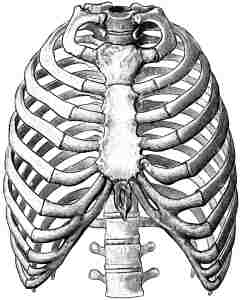

MedFriendly®


Thorax
1. In humans, the thorax is another name for chest, the cage
of bones and cartilage (a type of tissue) that extends from
the bottom of the neck to a muscle known as the diaphragm,
which separates it from the belly. The thorax protects
important parts of the body, such as those that assist in
breathing and pumping blood throughout the body.
Important body parts covered by the thorax include the heart,
lungs, and esophagus (the tube in the throat the food goes
down). Large blood vessels such as the aorta and arteries of
the lungs are covered by the thorax. The aorta is the largest
artery of the body. An artery is a blood vessel that carries
blood away from the heart.
The human thorax.
FEATURED BOOK: Chest Imaging Cases (Cases in Radiology)
The front of thorax is made up of 12 ribs, the sternum (the flat bone in the middle of the
chest), and cartilage that connects the ends of ribs with the sternum. The back of the
thorax is made up of 12 bones that form an opening in which the spinal cord passes. In
general, the thorax of a woman is smaller, has a shorter sternum (see above), and has
more movable upper ribs than the sternum of a man.
2. In insects, the thorax is the middle of the three main sections of the body. The thorax
also refers to similar areas on arachnids (insects with no spines) and crustaceans
(mostly water-dwelling creatures with an outer skeleton, such as crabs and lobsters).
"Where Medical Information is Easy to Understand"™
The plural of thorax is thoracis and thoraces. An
adjective used to describe the area of the thorax
is thoracic (also known as thoracal). Thoracic
also means pertaining to the part of the vertebrae
(bones that form an opening in which the spinal
cord passes) that are in the area behind the
thorax (see above for description).
There are 12 thoracic vertebrae, known as T1
through T12. Thoracic is also known as thoracal.
Thorax is Greek for "chest."
















